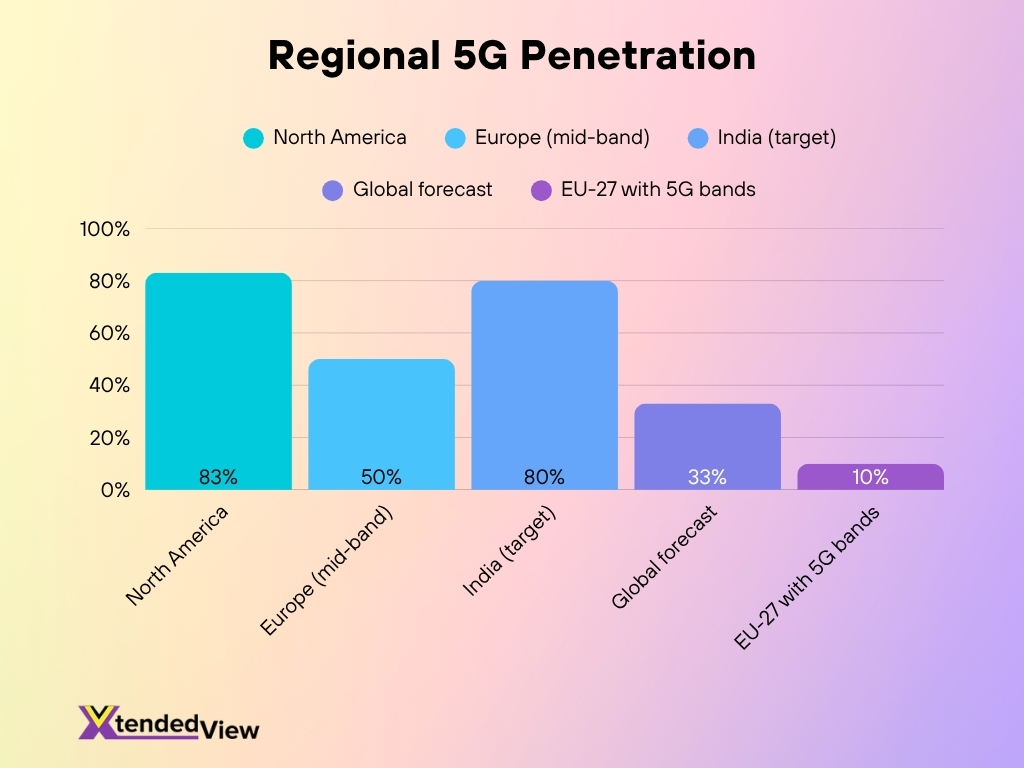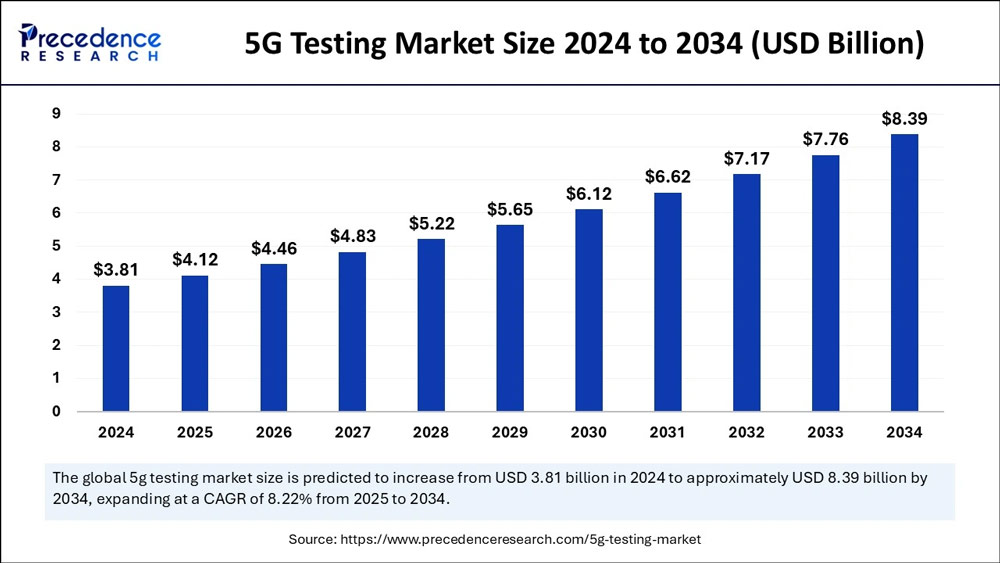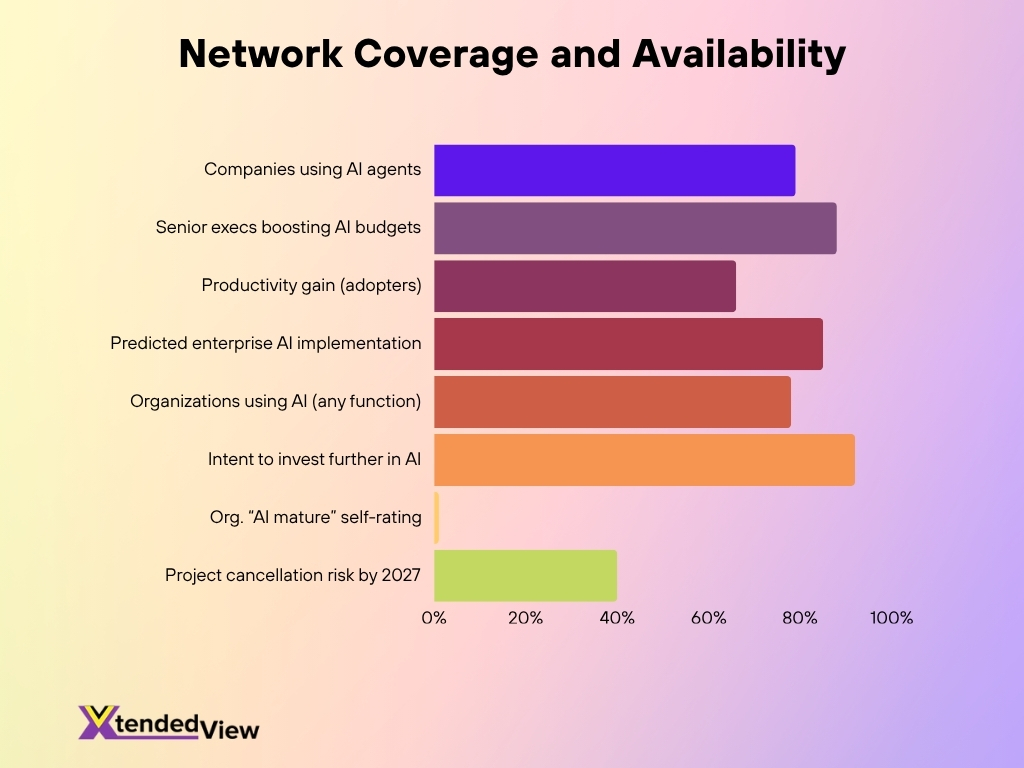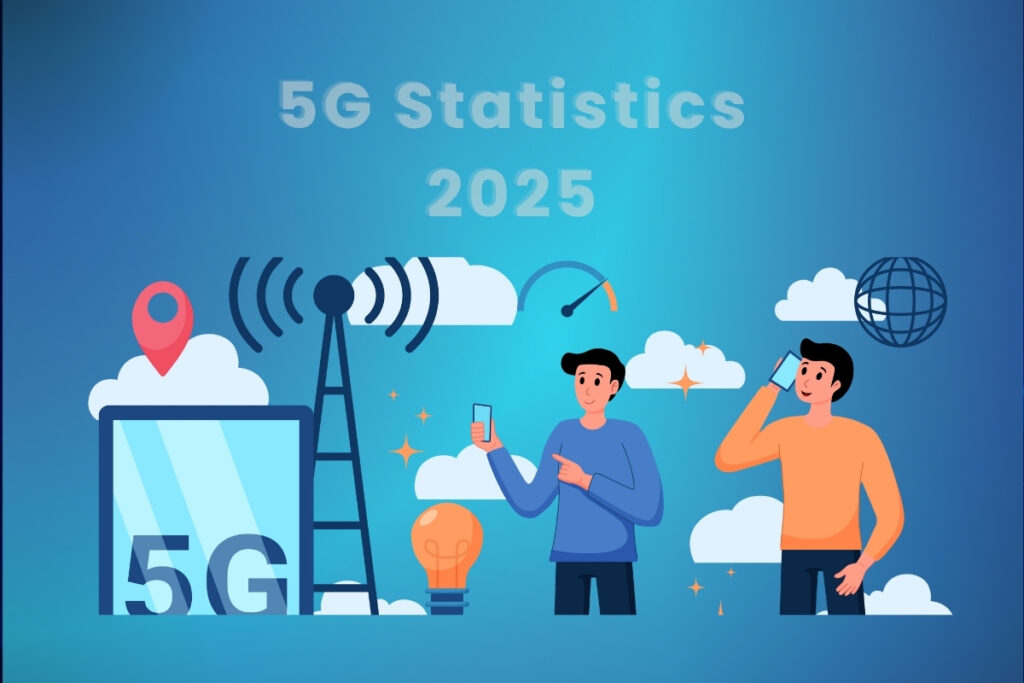Introduction
5G is no longer just a promise; by 2025, it is deeply reshaping mobile connectivity, enterprise networks, and the IoT ecosystem. In sectors like manufacturing, real‑time quality control runs on ultra‑low latency, while in smart cities, 5G powers responsive traffic systems and remote monitoring. The data and trends below reveal how rapidly 5G has expanded and where it is headed. Read on to see what 2025’s numbers mean for your industry.
Editor’s Choice
Here are seven standout 5G statistics for 2025 that set the stage:
- Global 5G connections reached 2.4 billion by Q1 2025.
- That number is forecast to hit 2.9 billion by end‑2025.
- 5G subscriptions may account for roughly one-third of all mobile subscriptions by the end of 2025.
- More than 619 operators across 184 countries are investing in 5G (trials, deployment, licensing).
- The 5G technology market is expected to grow at a CAGR from 18.5% to 21.5% across key countries.
- By 2025, 5G networks are projected to cover one‑third of the world’s population.
- In 2025, 5G users are predicted to consume over 1.2 trillion exabytes of data.
Global 5G Adoption and Growth
- At the end of March 2025, there were 354 commercial 5G networks globally.
- In 2024, global 5G connections totaled 2.25 billion, growing four times faster than 4G did at a comparable stage.
- From Q1 2024 to Q1 2025, operators added about 145 million new 5G subscriptions worldwide.
- The 5G growth rate now outpaces that of 4G in its own early expansion phase.
- By 2029, forecasts estimate 8 billion 5G connections globally.
- 5G now represents a significant share of new subscriptions in multiple markets (e.g., about one‑third globally) by 2025.
- The global wireless density has increased, about 1.5 wireless connections per person by the end of 2024.
- In North America, 5G adoption has reached 314 million connections, equating to ~83% population penetration.
5G Subscriptions Worldwide
- As of Q1 2025, global 5G subscriptions hit 2.4 billion.
- The June 2025 Ericsson Mobility Report expects 2.9 billion subscriptions by year-end.
- 5G is projected to account for ~one third of all mobile subscriptions by end‑2025.
- In 2024, 5G networks handled 35% of global mobile traffic.
- Between Q1 2024 and Q1 2025, mobile data traffic increased 19% globally.
- By 2030, 5G traffic share is projected to rise to 80%+ of mobile network traffic.
- Mid‑band 5G coverage in Europe reached 50% population coverage by end‑2024.
- In North America, 5G mid‑band coverage has exceeded 90% of the population.
Regional 5G Penetration
- North America has, 83% population with 5G connections as of Q1 2025.
- Europe, mid‑band 5G population coverage ~50% by end‑2024.
- India is targeting 80% 5G coverage of its population by 2025.
- In 2025, GSMA projects 5G will cover one‑third of the global population.
- Among EU‑27 countries, 24 support 5G bands beginning at 700 MHz and up to 3.8 GHz.
- In Europe, 5G deployment lags North America in mid‑band coverage.
- Many developing regions still trail in 5G access, especially in rural and low‑income areas.
- In Asia, China, South Korea, and Japan lead in dense urban deployment, though concrete recent stats vary.

Leading Countries in 5G Deployment
- China remains among the top 5G markets globally in scale and infrastructure investment.
- The U.S. saw aggressive mid- and high-band auctions (e.g., C‑band, mmWave) in recent years.
- South Korea has among the highest 5G penetration and performance metrics historically.
- India launched commercial 5G in 2022 and plans 80% coverage by 2025.
- European powerhouses (Germany, UK, France) continue major investments, though with a more cautious rollout.
- Japan’s spectrum allocations and operator plans support early adoption, especially in urban zones.
- Smaller advanced markets like Finland, Sweden, and Norway often lead in per capita deployment and innovation.
- In 2025, Huawei predicts over 100 million 5G‑Advanced compatible smartphones by year-end, indicating China’s push in next-generation tech.
5G Market Size and Forecast
- The global 5G technology market is projected to grow at 18.5% to 21.5% CAGR across key countries from 2025 onward.
- In some segments, like standalone 5G infrastructure, CAGR may reach 55.6%.
- The 5G-enabled data traffic is expected to exceed 1.2 trillion exabytes by 2025.
- Mobile data traffic will more than double through the forecast period up to 2030.
- 5G FWA is likely to account for over 35% of new fixed broadband connections by 2030.
- In 2024, over 50% of service providers offering FWA included speed‑based tiers (up from 40% in 2023).
- The broader 5G market (hardware, software, services) is expected to cross hundreds of billions USD in valuation in the latter half of the decade.
- Some analysts estimate the number of 5G connections could reach 9 billion by 2030.

5G Network Coverage and Availability
- By end‑2024, global 5G population coverage reached 55 percent.
- Outside mainland China, 5G coverage is projected to rise from 45 percent in 2024 to about 85 percent by 2030.
- In Europe, mid‑band 5G population coverage just crossed 50 percent by end‑2024.
- India’s 5G mid‑band population coverage is estimated at 95 percent by end‑2024.
- North America has achieved ~95 percent total 5G coverage, with mid‑band deployment hitting ~90 percent.
- Globally, only about 30 percent of network sites outside China are upgraded to mid‑band 5G as of 2024.
- Differences across regions persist; Latin America and Africa have mid‑band coverage levels around 10–20 percent as of 2024.
- In the EU, household 5G (NSA+SA) coverage reached 94.3 percent by end‑2024.

5G Devices and Infrastructure
- In 2025, global 5G smartphone sales are forecast at 153.3 million units, with ~35.6 percent year‑on‑year growth.
- Many new smartphones ship with multi‑band 5G support (low, mid, sometimes mmWave).
- The 5G infrastructure market is valued at USD 14.0 billion in 2025 and projected to grow to USD 574.4 billion by 2035 at a 45 percent CAGR.
- The 5G infrastructure equipment segment is expected to grow from USD 10.63 billion in 2024 to USD 19.57 billion in 2025.
- Hardware may claim ~52.4 percent share of the infrastructure market in 2025.
- Some analysts place the 5G infrastructure market at USD 43.5 billion in 2025.
- The private 5G market is forecast at USD 3.86 billion in 2025, growing to USD 17.55 billion by 2030.
- Many operators are investing in small cells, massive MIMO, and Open RAN architectures.
Performance: 5G Download and Upload Speeds
- In Q4 2024, the U.S. achieved a median 5G SA download speed of 388.44 Mbps, up from 305.36 Mbps a year earlier.
- Real‑world user speeds often range between 100 Mbps and 1 Gbps, depending on spectrum and density.
- Average marketed peak 5G download speed is ~768.6 Mbps, down slightly from 790.7 Mbps in late 2024.
- For LTE FWA, the marketed peak is ~150.8 Mbps.
- In U.S. mobile networks, T‑Mobile users saw average download speeds of> 150 Mbps.
- Upload performance is more moderate; Verizon achieved ~20.4 Mbps upload in U.S. tests.
- mmWave deployments can push speeds into the multi‑gigabit range under ideal conditions.
- Japan and China had median 5G SA speeds of ~254.18 Mbps and ~224.82 Mbps, respectively, in Q4 2024.
5G in Fixed Wireless Access (FWA)
- By the end of 2024, 5G handled ~35 percent of global mobile traffic.
- 5G FWA is projected to be >35 percent of new fixed broadband connections.
- In 2025, ~98.55 million FWA connections are forecast for 5G.
- The FWA market is valued at around USD 41.2 billion in 2025, growing to USD 144.7 billion by 2035.
- The 5G segment may command ~48.3 percent share by 2025.
- Average 5G FWA-marketed peak download speeds (~768.6 Mbps) far exceed LTE FWA (~150.8 Mbps).
- Use of 5G FWA is particularly attractive in rural or underserved areas.
- Some operators now bundle FWA with mobile services to improve ARPU.
5G Impact on Mobile Data Traffic
- Between Q1 2024 and Q1 2025, global mobile data traffic increased by 19 percent.
- Mobile data traffic is predicted to more than double over the forecast period.
- In 2024, 5G networks already were carrying 35 percent of total mobile traffic.
- By 2030, forecasts expect 80 percent+ of mobile traffic to run on 5G.
- In European networks, ~10 percent of subscribers generated ~65 percent of traffic in 2024.
- Subscribers over 50 GB/month (≈3 percent of users) generated ~37 percent of traffic.
- Web browsing’s share dropped from ~14 percent in 2020 to ~7 percent in 2024, while video traffic rose sharply.
- Gaming traffic rose ~8 percent in share over 2020–2024, reaching ~1.5 percent of total traffic.
5G Use Cases and Industry Applications
- Enhanced Mobile Broadband (eMBB): video streaming, AR/VR, immersive experiences, benefiting from higher throughput and capacity.
- Fixed Wireless Access (FWA): offering broadband via 5G where wired infrastructure is weak or absent (rural, underserved areas).
- IoT and mMTC: massive device connectivity (sensors, smart meters) across cities, agriculture, and logistics.
- Ultra-Reliable Low-Latency Communications (URLLC): remote surgery, autonomous vehicles, real-time industrial control.
- Smart manufacturing: real-time analytics and control on factory floors using private 5G networks.
- Smart cities and infrastructure: traffic management, environmental sensors, video surveillance using 5G backbone.
- Augmented reality, cloud gaming, immersive media: enabled by low latency and high throughput.
- Enterprise private networks: sectors like energy, logistics, ports, airports, and mining are deploying their own 5G slices.
5G in Internet of Things (IoT)
- The growth of massive Machine-Type Communications (mMTC) enables billions of low-power, low-data sensors.
- Tens of billions of IoT devices are expected to connect via 5G by the late 2020s.
- Industrial settings use 5G IoT for predictive maintenance, asset tracking, and process automation.
- Smart cities deploy 5G IoT for environmental sensing, waste management, and public safety.
- In agriculture, 5G IoT enables precision farming with sensors, drones, and automated irrigation.
- Retail and logistics use 5G IoT for inventory tracking and cold chain monitoring.
- Energy and utilities benefit from 5G IoT for smart metering and grid monitoring.
- With edge computing, 5G IoT systems process data near the device, reducing latency.
Enhanced Mobile Broadband (eMBB)
- eMBB supports gigabit‑level data rates for HD video, VR/AR, and immersive media.
- Many 5G deployments achieve 100 Mbps to 1 Gbps in real-world urban zones.
- eMBB drives the largest share of 5G services revenue across global markets.
- The global 5G services market was valued at USD 125.36 billion in 2024.
- In 2025, projections place it at USD 200.55 billion.
- By 2030, 5G networks are expected to carry 80 percent or more of mobile traffic, with eMBB dominating.
- Video streaming already accounts for over 60 percent of mobile traffic.
- Smart factories combine eMBB with URLLC and mMTC through network slicing.
Ultra-Reliable Low-Latency Communication (URLLC)
- URLLC delivers latency as low as 1 ms and 99.999 percent reliability.
- It supports critical applications like autonomous driving and remote surgery.
- URLLC provides low throughput but strict latency and reliability.
- Service forecasts assign significant growth to URLLC by 2029.
- 5G-Advanced introduces upgrades to further reduce latency.
- Balancing URLLC, eMBB, and mMTC in one network poses technical challenges.
- Industrial automation and mission-critical operations depend on URLLC.
- Network slicing allows dedicated URLLC lanes for reliable performance.
Massive Machine-Type Communications (mMTC)
- mMTC connects hundreds of thousands of low-data, low-power devices per square km.
- It emphasizes energy efficiency, cost reduction, and scalability.
- Devices transmit periodic, low-priority data (e.g., temperature, usage).
- Deep sleep and power-saving protocols extend battery life.
- mMTC enables smart metering, city sensors, and agriculture automation.
- It serves as the foundation for smart infrastructure deployments.
- mMTC makes up a growing segment of 5G’s non-eMBB traffic.
- Pilot projects already use mMTC in utilities and smart grids.
Key 5G Service Providers and Companies
- Huawei projects 100 million 5G-Advanced phones by late 2025.
- Nokia plans large-scale 5G equipment deployment in India from 2026.
- Ericsson, Nokia, and Huawei lead the global 5G infrastructure.
- Open RAN initiatives aim to lower costs and expand vendor diversity.
- U.S. operators like Verizon, AT&T, and T-Mobile continue aggressive rollouts.
- China’s ecosystem involves major players like China Mobile and ZTE.
- The 5G services market may grow from USD 125.36 billion to over USD 2.2 trillion by 2030.
- 5G-Advanced is projected to be a USD 350 billion market by 2028.
5G Contribution to the Global Economy
- 5G is expected to add nearly USD 900 billion to global GDP by 2030.
- Productivity gains in manufacturing, logistics, and services drive this growth.
- The 5G services economy could exceed USD 2.2 trillion by 2030.
- In MEA regions, 5G is linked with boosts in digital GDP.
- In the U.S., 5G FWA supports broadband access in underserved areas.
- Operational savings from automation and edge computing contribute to efficiency.
- Enterprises use 5G to launch new services and revenue models.
- Some studies predict a multi-trillion-dollar economic impact by 2035.
Security and Energy Efficiency in 5G
- The 5G security market reached about USD 1.8 billion in 2024.
- Increased connectivity expands potential attack surfaces.
- 5G improves security through encryption, slicing, and authentication.
- Vulnerabilities still exist at the handover and signaling levels.
- Energy efficiency improves with newer hardware and smart algorithms.
- 5G equipment is estimated to be 10 times more energy-efficient than 4G.
- Research continues into power-aware scheduling and adaptive radio features.
- Operators use sleep modes and AI to minimize power use.
Future Trends: 5G-Advanced and Beyond
- 5G-Advanced (Release 18) offers better spectral efficiency and reliability.
- It supports XR, network AI, and industrial-grade URLLC.
- 5G-Advanced may hit USD 350 billion in commercial value by 2028.
- Pilots are underway in Asia and Europe for 5G-A capabilities.
- 6G is expected around 2030, focusing on integrated AI and sensing.
- Edge computing and ML will dominate post-5G architectures.
- Non-terrestrial networks (satellites, UAVs) are gaining traction.
- Efficiency and sustainability will define future network evolution.
Recent Developments
- Huawei expects 100 million 5G-Advanced smartphones by 2025.
- Nokia plans aggressive 5G gear rollout in India for 2026.
- Top 2025 trends include Open RAN, beamforming, and slicing.
- MEA region shows rapid digital transformation driven by 5G.
- Spectrum policy and 5G regulation continue evolving globally.
- First commercial deployments of 5G-Advanced are appearing.
- Green 5G and energy-aware scheduling are now operator priorities.
Frequently Asked Questions (FAQs)
2.4 billion 5G connections globally in Q1 2025
Projected to reach USD 2,208.25 billion by 2030 with a 62.2 % CAGR (2025–2030)
5G accounted for 35 % of global mobile data traffic by end‑2024, and is forecast to reach 80 % by 2030
3,378 announced devices catalogued, of which 2,977 (≈ 88.1 %) were commercially available
The global 5G infrastructure market is estimated at USD 14.34 billion in 2025 and is projected to reach USD 155.32 billion by 2035, at a 26.9 % CAGR, according to MarketsandMarkets
Conclusion
By 2025, 5G is no longer emerging; it is embedded in global networks, powering everything from video streaming to industrial automation. The three service pillars, eMBB, URLLC, and mMTC, each bring unique demands, tradeoffs, and opportunities. Key players are pushing into 5G‑Advanced territory already, and the economic stakes are high. But challenges around security, energy, and coexistence remain. Looking ahead, 5G’s evolution into 5G‑Advanced and preparations for 6G will determine whether the technology lives up to its transformative promise. If you’re curious how these numbers translate into business strategy, keep going with the full article.


